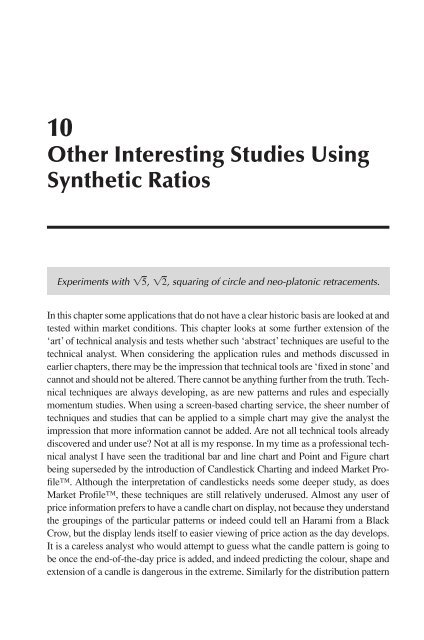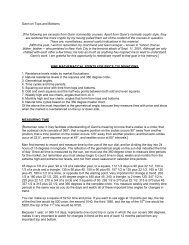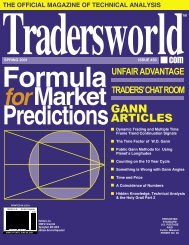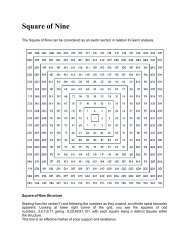Fibonacci and Gann Applications in Financial Markets
Fibonacci and Gann Applications in Financial Markets
Fibonacci and Gann Applications in Financial Markets
Create successful ePaper yourself
Turn your PDF publications into a flip-book with our unique Google optimized e-Paper software.
10<br />
Other Interest<strong>in</strong>g Studies Us<strong>in</strong>g<br />
Synthetic Ratios<br />
Experiments with 15,<br />
12,<br />
squar<strong>in</strong>g of circle <strong>and</strong> neo-platonic retracements.<br />
In this chapter some applications that do not have a clear historic basis are looked at <strong>and</strong><br />
tested with<strong>in</strong> market conditions. This chapter looks at some further extension of the<br />
‘art’ of technical analysis <strong>and</strong> tests whether such ‘abstract’ techniques are useful to the<br />
technical analyst. When consider<strong>in</strong>g the application rules <strong>and</strong> methods discussed <strong>in</strong><br />
earlier chapters, there may be the impression that technical tools are ‘fixed <strong>in</strong> stone’<strong>and</strong><br />
cannot <strong>and</strong> should not be altered. There cannot be anyth<strong>in</strong>g further from the truth. Technical<br />
techniques are always develop<strong>in</strong>g, as are new patterns <strong>and</strong> rules <strong>and</strong> especially<br />
momentum studies. When us<strong>in</strong>g a screen-based chart<strong>in</strong>g service, the sheer number of<br />
techniques <strong>and</strong> studies that can be applied to a simple chart may give the analyst the<br />
impression that more <strong>in</strong>formation cannot be added. Are not all technical tools already<br />
discovered <strong>and</strong> under use? Not at all is my response. In my time as a professional technical<br />
analyst I have seen the traditional bar <strong>and</strong> l<strong>in</strong>e chart <strong>and</strong> Po<strong>in</strong>t <strong>and</strong> Figure chart<br />
be<strong>in</strong>g superseded by the <strong>in</strong>troduction of C<strong>and</strong>lestick Chart<strong>in</strong>g <strong>and</strong> <strong>in</strong>deed Market Profile.<br />
Although the <strong>in</strong>terpretation of c<strong>and</strong>lesticks needs some deeper study, as does<br />
Market Profile, these techniques are still relatively underused. Almost any user of<br />
price <strong>in</strong>formation prefers to have a c<strong>and</strong>le chart on display, not because they underst<strong>and</strong><br />
the group<strong>in</strong>gs of the particular patterns or <strong>in</strong>deed could tell an Harami from a Black<br />
Crow, but the display lends itself to easier view<strong>in</strong>g of price action as the day develops.<br />
It is a careless analyst who would attempt to guess what the c<strong>and</strong>le pattern is go<strong>in</strong>g to<br />
be once the end-of-the-day price is added, <strong>and</strong> <strong>in</strong>deed predict<strong>in</strong>g the colour, shape <strong>and</strong><br />
extension of a c<strong>and</strong>le is dangerous <strong>in</strong> the extreme. Similarly for the distribution pattern






